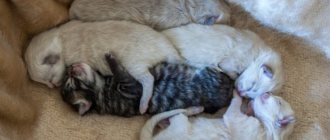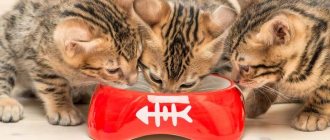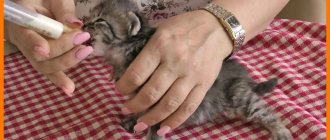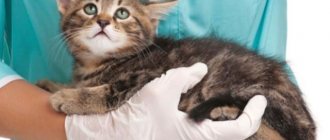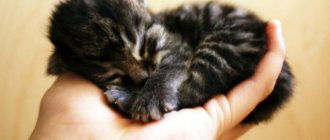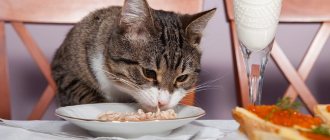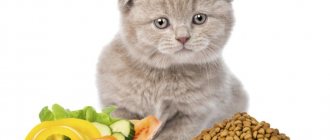Feeding a newborn kitten happens for various reasons. In any case, this is a serious responsibility for a small life.
The neonatal period for kittens ends at the age of two weeks. But these first two weeks of life play a decisive role not only in the future health of babies, but also for their very existence. During these two weeks, the kitten adapts to living outside the mother’s body, organs and systems continue to develop, breathing and circulatory processes normalize, the endocrine glands begin to work, changes in metabolism occur, and normal thermoregulation is established. And if during this period the owner is inattentive to the feeding procedure, then in addition to the development of diseases, this can lead to the death of the baby.
Temperature regime for newborn kittens
It is necessary to feed orphaned kittens as early as possible, so that no more than a day passes after birth. But even more important is to keep them warm. Newborns cannot regulate their body temperature and are at risk of hypothermia outside their cozy den.
A heating pad will replace your mother's warm side. If you don’t have a special rubber heating pad, you can take a regular plastic bottle. The container is filled with boiling water and wrapped in a terry towel in several layers. This way the kitten will not get burned, and the water will cool more slowly. Depending on the temperature in the room, the hot water will have to be changed. In an apartment where it is about 20o, the heating pad keeps warm for about 6 hours. If the kittens are restless and huddle together, check the temperature of the heating pad.
For the first week, you should always have a heating pad on, change the water even at night. It becomes unnecessary when kittens reach one month of age. But knowing the love of cats for warmth, you can continue to apply the heating pad longer.
If there are a lot of kittens, then the box should be large. But then the blind kitten may get lost, bumping into the wall, and freeze. To prevent this from happening, you need to place bottles of hot water against each wall, and leave a free space in the center where the kittens can crawl. The cubs can simply snuggle up to the heating pad, or they can climb onto it and sleep on top.
How often should you feed
It is imperative to follow the regime and monitor the portions of the mixture. For the first two weeks, you will have to feed the kitten every 2 hours, even at night. Then the intervals are gradually shortened. After five weeks, the kitten can easily survive without food for 3-4 hours, and at night one feeding is enough for him.
At 6 weeks of age, babies feed on their own: they need to be fed up to 5 times a day and only during the daytime. Kittens grow very quickly, so the nursing period will not seem very long.
Setting up a den for newborn kittens
Even the tiniest, still blind kittens can scatter in search of their mother, food or a source of warmth. To avoid trouble, it is necessary to exclude the possibility of escaping from the “nest”. The traditional, time-tested option is a cardboard box. Newborn kittens will not soon be able to get out of it on their own. The box should not be a shoe box, but with high walls.
Cardboard is a warm and safe material, and if the box becomes unusable, you can simply throw it away and replace it with a new one. An alternative is a deep plastic box or container, but in this case the ventilation is worse, and the container itself will have to be washed and disinfected periodically.
Place bedding on the bottom. A convenient option is disposable absorbent diapers, but the downside is that it can bunch up and clump if you do not attach it with tape or an adhesive edge. Fleece has proven itself to be excellent - it dries quickly, is warm and soft. Woolen products are absolutely not suitable, although they are often placed on kittens for “entourage”. The claws may get tangled in the fur, causing injury to the kitten. In addition, babies acquire the bad habit of sucking wool and may swallow thread.
Organizing a place for kittens to stay
If a one-month-old kitten is already more independent and does not require special conditions of maintenance, then newborn babies are a completely different matter. So, you need to remember that a cat’s normal body temperature is within 38 ºС. That is why there should be such a slightly elevated temperature in the kittens’ nest. To do this, you can use heating pads or electric heaters, securely hidden under several layers of fabric. Also, the kittens’ place of stay will need to be lined with soft natural fabric (best of all, a baby flannel diaper), which will need to be washed periodically (getting rid of the baby’s waste). To keep the “nest” warm, it is better to cover it with something woolen (it could be an old grandmother’s scarf).
It is important to note that experts advise organizing the place where babies stay in a basin, and not in a cardboard box. And all because this container does not absorb odors and is a more hygienic option.
Is it possible to keep newborn kittens together?
If there are several kittens, they are usually kept together. This makes it easier for babies to stay warm by snuggling together. Living warmth and the presence of relatives calms and creates a feeling of security.
But there are exceptions to every rule. During the first week, kittens should not be left with each other unattended, as their umbilical cord has not yet healed. Up to the age of one month, observe how babies interact with each other. Without round-the-clock access to the mother's breast, hungry kittens can cling to each other. This can be very dangerous - babies leave each other serious bruises, most often in the genital area and abdomen. They can suck ears and tails. If nothing is done, inflammation begins, especially in weak kittens.
To prevent kittens from sucking each other, they need to be fed and picked up as often as possible. But most often we have to separate the kids. Be careful.
The sucking reflex persists in orphan kittens for a very long time. Sometimes a cat raised without a mother sucks the owners fingers, earlobes, clings to the skin of the hands or chews hair until death.
When can a kitten be switched to self-feeding, at what age can a pet eat on its own?
From about one month of age, complementary foods should be introduced to the kitten, without stopping formula feeding. Baby purees containing meat ingredients are successfully used as complementary foods. It is not advisable to start feeding your baby meat or fish until he can digest such rough food.
After one and a half months, the kitten’s body is already ready to feed itself on “adult” food. Naturally, his diet should be as soft and gentle as possible.
Nutritional needs of newborn kittens
Kittens are born without a fat layer and without a reserve of carbohydrates (in adult animals, this role is played by glycogen in the liver and muscles). They need regular, nutritious food and eat very often.
Babies do not yet have free hydrochloric acid in their stomach (it begins to be produced by the age of 3-4 weeks). Therefore, it is unacceptable to start complementary feeding before 3 weeks of age. Newborn kittens can only eat milk. But not just any milk!
When preparing a diet for a small kitten, you need to focus on the composition of cat's milk. Its main feature is its high protein and fat content. Neither cow's nor goat's milk can replace a kitten's mother's milk, which contains about 10% fat and 11% protein. By comparison, cow's milk contains only 3.5% protein. The content of milk sugar, lactose, also differs. There is much less of it in cat milk.
In addition to proteins, fats and carbohydrates, a kitten needs vitamins and minerals for normal development. This includes a special fatty acid – docosahexaenoic acid (DHA, or DHA). It belongs to Omega-3 fatty acids, a good source of which is fish oil.
Contrary to popular belief, infant formula is also not suitable for feeding kittens. The nutritional needs of human and feline babies are very different.
You can buy formula for kittens at a pet store or veterinary pharmacy (cat's milk substitute), or prepare it yourself at home.
The main thing in feeding
It's time to figure out how to feed kittens without a cat. Initially, you need to understand what you can feed such babies. Of course, you can feed them with cow's milk, but experts do not advise doing this. And all because the composition of cow's and cat's milk is significantly different. It is very important. Thus, cat milk contains much more protein, fat, and ash substances. It is these elements that are important for the proper growth and development of motherless kittens.
Milk replacers for newborn kittens
Feeding newborn kittens has now become much easier - you can buy ready-made milk formula for kittens at a pet store. I recommend this particular option - an industrial substitute for cat milk, without being tied to a specific company. All of them have proven themselves well.
- Royal Canin Babycat Milk (includes measuring spoon, bottle and several nipples with holes of different diameters)
Royal Canin cat milk replacer
- Beaphar Kitty-Milk (there is a measuring spoon, but the feeding kit will have to be purchased separately)
Beafar cat milk replacer
- Gimpet Cat-Milk (no measuring cup, you can use a regular spoon, diluting the mixture 1:3 with hot water)
The dosage indicated per 100 g of kitten weight is not one-time, but daily. This amount should be evenly divided into several feedings.
Weigh your kitten to get an idea of how much food he needs.
Amount of formula for one feeding
It’s not difficult to determine whether a kitten is getting enough. Hungry babies constantly squeak and crawl in search of their mother. If you present them with a finger, they immediately strive to suck it. Well-fed kittens are calm and... Having eaten, they go to bed.
There are also certain physiological factors that indicate both that the baby is overeating and that he is undernourished. We're talking about kitten poop :
- With slight overfeeding - liquid and yellow
- With moderate overfeeding - greenish
- With constant overfeeding - gray
Please note that you need to pay special attention to gray or white feces, as these colors of feces may indicate infectious diseases in the kitten.
If the kitten is malnourished, it sleeps little, trembles, squeaks and is lethargic. Besides that, kittens. Babies who receive too little food practically do not gain weight.
© shutterstock
How to prepare kitten formula at home
Often, orphan kittens end up in people's care quite suddenly. What if the industrial cat milk substitute is not sold anywhere (delivery is only possible from another city), or the store is simply closed for the night, or there is simply no money?
The first thought is to give the kittens regular milk, some recommend goat milk. Although this is not suitable food for them, it is acceptable as “first aid”. But 10% cream is much better. At first glance, they are very fatty; cream seems like heavy food to us. But cat milk contains 9-11% fat, and 10-11% cream is what you need. They will be absorbed better than “watery” milk.
Cream is absorbed better than milk
In the future, you need to prepare a mixture for kittens that is balanced in nutrients. Its main difference from regular cream will be the high percentage of protein. For feeding kittens from birth to 3 weeks, mix:
- 380 ml cow's milk 1.5%
- 25 g raw egg yolks (the amount depends on the type of egg)
- 15 g vegetable oil
- 75 g low-fat lactose-free cottage cheese
- 1.5 g evening primrose oil (source of vitamin E)
- 200 mg taurine
- 5 g vitamin and mineral supplement (20% calcium)
Mix with a blender and heat to 35°C.
Cat mixes
Milk replacer for kittens can be purchased at the store. This is the best option. However, this may not be available to everyone. In this case, you need to prepare the mixture yourself. Moreover, this is not a problem. After all, there are many different recipes on how to do this.
- It is necessary to dissolve the egg yolk in half a liter of cow's milk, as well as about 4 tsp. granulated sugar.
- Mix 50 ml of boiled and 50 ml of whole cow's milk, add half an egg yolk and 1 tsp. corn vegetable oil.
- Mix 50 ml of whole cow's milk with 15 g of the same milk in powder form. Add a little more than 2 g of dry yeast to this.
- Dilute powdered milk in fennel broth to the consistency of a viscous slurry. You can also add a little cream there to increase the fat content of the mixture.
- Dilute a glass of 10% cream with boiled water in a 1:2 consistency.
All these recipes can be used without fear, because these mixtures are easily tolerated by kittens. However, it is important to remember: food prepared in advance should not be stored for more than a day (in the refrigerator, of course). And, of course, kittens’ food should be heated to a temperature of 38ºC immediately before feeding.
Regime and rules for feeding newborn kittens
Newborn kittens need to be fed as often as possible - this is an axiom. It is natural for them to eat often, but little by little. Unfortunately, one person simply cannot provide orphans with round-the-clock access to a bottle.
How often should kittens be fed depending on age:
A newborn kitten sucks until it is satisfied, and then falls asleep again. Feeding itself does not take much time, usually no more than 5 minutes.
Kittens eat often, but little by little
1 week – every 2 hours, including at night. More often if the kittens wake up and squeak (sometimes you have to feed them every hour).
Week 2 – every 3 hours, at night every 4 hours.
Week 3 – feeding every 3-5 hours, at night the interval can be 6 hours if the kittens do not wake up.
4th week – kittens are fed on average 4-6 times a day (every 4-6 hours), by the end of the week they begin to introduce complementary foods.
Month-old kittens begin to eat special canned food
How to prepare the mixture
If you are using a commercial milk replacer, detailed instructions will be provided on the packaging. The general principle is this: boil water and let it cool to about 50°C. Pour the mixture powder into the water, stirring constantly so that there are no lumps. The prepared solution is poured into bottles. When the milk has cooled to 35-36oC, it is given to kittens.
Common mistakes: pour the powder with water, and not vice versa; use boiling water instead of hot water
It is not recommended to store the finished mixture. But this is perfectly acceptable if you keep it in the refrigerator. A pre-prepared solution at night is especially helpful. Then you only need to heat the milk to the desired temperature - in the microwave or in a water bath.
Be sure to check the temperature of the milk by placing a drop on your wrist before giving the bottle to your kitten.
How to feed a newborn kitten
Ideally, the kitten is fed from a special bottle with a nipple, and the diameter of the nipple hole varies depending on the age of the baby. In real life, buying such a bottle can be a problem. An alternative would be a plastic syringe without a needle.
The kitten is fed by holding it upright if it is very small, or lying on its stomach. It is strictly forbidden to place the kitten on its back. Kittens must suck the bottle or syringe nozzle themselves; pouring the mixture into them is unacceptable - it can get into the respiratory tract.
Kitten drinks from a bottle
Many newborn kittens die from aspiration pneumonia caused by improper feeding, and not at all from a draft or viral infection. No force feeding.
The bottle is held at an angle of 45°C, it should be comfortable for the kitten to suck. The muzzle will be raised up.
The correct position of the bottle is at an angle of 45 degrees
How much milk to give a kitten at one time
The amount of formula fed to a kitten depends on the age and weight of the baby. Kittens are usually fed ad libitum so that the sleepy baby falls off the nipple on its own. But sometimes overfeeding leads to digestive problems, and you need to at least approximately adhere to the standards indicated on the packaging of the cat's milk replacer.
In the first week the kitten will drink about 2-5 ml at a time, in the second week 5-10 ml, then 10-15 ml.
Cow's milk or baby formula is too watery for kittens. Their kitten will drink more, stretching its stomach and suffering from colic. Cat milk replacer is high in protein and fat. It is more concentrated, more nutritious. And you only need a little bit of it in terms of volume.
Kittens are not given water until they begin to lap from the bowl on their own.
Tummy massage
After each feeding, the kitten is helped to relieve itself. To do this, carefully massage the tummy clockwise. In addition, you need to massage the anus with a damp cotton pad or napkin, imitating the movements of a cat's tongue.
Urination should occur after each meal, and bowel movements on average 4 times a day. The stool should be light brown and soft. Kittens will only have formed stools when they start complementary feeding. The butt is wiped first with a damp and then with a dry cloth.
Kittens must poop from the first day of birth. If there are no stools, a veterinarian's examination is necessary. The kitten may have congenital underdevelopment or occlusion of the anus and other problems.
The kitten needs not only to be fed, but also to be helped to defecate.
Weighing
To make sure that kittens are digesting food and growing, they need to be weighed. In the first week it is better to do this daily. The weight gain should be about 15 grams. You can weigh babies using electronic baby scales or kitchen scales. If the scales are not equipped with a bowl, the kitten is placed in a container.
This kitten's eyes haven't opened yet. Weighing on a kitchen scale
This kitten weighs almost 700g and can eat dry kitten food
Features of feeding by month
In the first month, the kittens' diet consists of dairy products, to which other foods are gradually added. In the second week, complementary foods in the form of meat broth begin to be introduced. As the kitten grows, it is fed minced poultry meat. It is also recommended to give various cereals and egg yolk.
From 1 month onwards, the diet includes more solid food - meat cut into small pieces, fruits and vegetables.
By 6 months you should stop drinking milk in its pure form. This is due to the fact that the kitten noticeably decreases the secretion of the enzyme lactase, which breaks down disaccharides, so diarrhea, vomiting and general malaise occur when using the product. Milk is replaced with fermented milk products - fermented baked milk, cottage cheese.
As you grow, other foods besides the mixture are included in the diet; nutrition can be:
- natural;
- ready;
- combined.
For kittens, both the regimen and the feeding process itself are important. Insufficient food can lead to exhaustion or impaired development of the pet. Failure to follow feeding rules leads to aspiration of the respiratory tract with food and other pathologies.
What to do if your kitten is constipated
Irregular bowel movements are the most common problem in newborn bottle-fed kittens. Owners complain that it is not as difficult for them to feed the brood day and night as it is for them to force the babies to poop.
For good digestion, you need to use a professional cat's milk replacer and regularly massage the kittens' belly. But what if kittens are still constipated?
Veterinarians prescribe petrolatum oil orally 2 times a day. And safe laxatives are given in a course every day, for example - Lactusan. If there has been no stool for a long time, it becomes dense and the kitten will not be able to poop on its own. Then you need a small enema (1.5-2 ml). Cool water is mixed with Vaseline oil and injected into the anus using a syringe without a needle.
If constipation alternates with diarrhea, and the tummy is unnaturally round and swollen like a drum, the cause may be a huge number of worms in the intestines.
Stray kittens are always infected with parasites
When a newborn kitten may need human help
There are quite a lot of circumstances under which it is impossible for a cat to care for kittens. We list the main ones:
- death of an animal during childbirth;
- complicated birth, after which the cat needs time to recover;
- lack of lactation;
- insufficient milk to feed the entire brood.
In addition to the above, it also happens that a cat may simply refuse to care for her offspring, not allowing the kittens to come near her. In all these cases, the owner must take on the burden of caring for the newborn.
How to determine the age of a kitten
When nursing kittens, it is very important to know exactly their age, because the acceptability of this or that food for them, as well as the feeding regimen and norms, depends on this.
Newborn kittens, which have a small remnant of the umbilical cord on their tummy in the form of a characteristic “tail,” cannot be older than one week. Usually it disappears on its own approximately 3 days after birth, but sometimes this period shifts slightly upward.
A kitten with an umbilical cord cannot be older than 1 week
When conducting an external examination of a kitten, you should pay attention to its eyes. If they are closed, then the baby has not crossed the two-week mark of life. If the eyes are slightly open but remain narrow, then he is about 3 weeks old. They open completely when they are about a month old.
If the kitten's eyes are slightly open, he is 2 to 3 weeks old.
You should also pay attention to your baby's teeth. The first incisors appear in the third week of life. All teeth erupt by 4 months. And after the 5th month they begin to be replaced by radical ones.
The ears can also provide information about the age of the kitten. They are fully expanded by 3 weeks. Newborn babies' ears are completely pressed to their head.
The kitten's ears are completely straightened - the baby is over 3 weeks old
A fairly accurate method of determining the age of a kitten is to weigh it:
- a newborn weighs about 100 grams;
- at the age of 2 weeks the weight will be about 200 grams;
- a month-old kitten weighs 250–300 grams.
Undoubtedly, weight is greatly influenced by the baby’s nutrition and health status, therefore, to obtain a reliable result, it is necessary to evaluate all of the above signs comprehensively.
Do you need veterinarian help?
If the cat refuses to feed the kittens or dies in childbirth, then immediately after their birth it is necessary to call a veterinarian to examine the newborns. The specialist will be able to assess the health of the babies and give recommendations on care and feeding.
If the kittens are developing normally, then there is no need for additional consultations with a veterinarian. However, if the kitten is sick or does not gain the weight required for its age, then the help of a specialist in this case is necessary.
Is it true that artificial kittens get sick more often?
There is a persistent myth according to which kittens deprived of their mother's milk will suffer from some illness throughout their lives. Allegedly, they have extremely weak immunity and a digestive system that has been torn since childhood.
As usual, there is some truth here. Breast milk is really difficult to replace with artificial formula, and the consequences of such feeding can appear years later. But think about this - millions of human babies are raised on formula and are no different from those people who were breastfed as children.
Kittens receive protection from infections from mother's milk only in one case - if antibodies to viruses are in the blood of the cat itself. This is called colostral immunity. If a nursing cat has not been vaccinated, then her kittens are just as defenseless against viruses as bottle-fed kittens. Babies receive preventive vaccinations as early as possible (the first at 2 months with revaccination at 3 months). And complementary foods are introduced as quickly as possible, nevertheless continuing to give a cat's milk substitute for up to 1.5-2 months.
Rumors about the illness of orphaned kittens have a different background. For example, a pregnant cat was starving, which prevented the correct formation of the fetuses.
If the cat lived in good conditions, and the kittens received good genes from both parents, then artificial feeding will not prevent the babies from growing into beautiful and healthy animals.
Additional care
In order to leave a newborn kitten without a mother cat, in addition to feeding, you should provide adequate care, because the baby is not yet able to care for itself:
- Cosiness. Place the pet in a separate box with warm bedding on the bottom. If there are other animals in the house, their access to this box should be limited. If there were several abandoned kittens, they should be placed together.
- Heating. Until two weeks of age, your pet should be provided with additional comfortable warmth. You need to heat the heating pad to a temperature of 37-38 degrees and wrap it in a towel. Place a heat source near the baby.
- Hygiene procedures . Before feeding and after the procedure, you should wipe the anus with a soft cloth soaked in warm water. You should also periodically lay the baby on his back and wipe his tummy and butt, directing movements in one direction. This allows you to stimulate the bladder and intestines and help relieve need. Urine and feces should be light and odorless. If the stool is dark in color and has an unpleasant odor, you should contact your veterinarian.
- The washing up. If the fur gets dirty, you should wash your pet. Wet the tip of the towel in warm water and wipe the back and stomach. After this, wipe it dry, change the bedding and place it near the heating pad.
Artificial feeding and care cannot fully replace a kitten’s mother, but it can help it survive and adapt to new conditions.
The main thing is to show patience, perseverance, and feed your pet regularly, because its life depends on it.
Recipes for making your own mixture
If the kitten tolerates pasteurized cow's milk well, then you can make him dishes based on it. To prepare the classic recipe you will need:
- a glass of warm milk;
- 2 chicken egg yolks;
- vegetable oil - 1 teaspoon;
- 1 drop of multivitamin solution (for example, Trivita or Tetravita).
If the kitten is very weak and thin, you can prepare a sweet mixture based on condensed milk - it contains enough fats and carbohydrates so that the baby quickly gains weight and gets stronger. It is made according to the following recipe:
- Condensed milk is mixed with water in a ratio of 1:5.
- Add bone meal at the rate of 1 teaspoon per liter of liquid.
This dish is only allowed to be given to kittens over 1 week old. Suitable only for emergency feeding (after 5–7 days you should switch to a regular formula with milk or a powder substitute).
